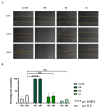Establishment and Characterization of Cell Lines from Canine Metastatic Osteosarcoma
- PMID: 38201229
- PMCID: PMC10778184
- DOI: 10.3390/cells13010025
Establishment and Characterization of Cell Lines from Canine Metastatic Osteosarcoma
Abstract
Despite the advancements in treatments for other cancers, the outcomes for osteosarcoma (OSA) patients have not improved in the past forty years, especially in metastatic patients. Moreover, the major cause of death in OSA patients is due to metastatic lesions. In the current study, we report on the establishment of three cell lines derived from metastatic canine OSA patients and their transcriptome as compared to normal canine osteoblasts. All the OSA cell lines displayed significant upregulation of genes in the epithelial mesenchymal transition (EMT) pathway, and upregulation of key cytokines such as CXCL8, CXCL10 and IL6. The two most upregulated genes are MX1 and ISG15. Interestingly, ISG15 has recently been identified as a potential therapeutic target for OSA. In addition, there is notable downregulation of cell cycle control genes, including CDKN2A, CDKN2B and THBS1. At the protein level, p16INK4A, coded by CDKN2A, was undetectable in all the canine OSA cell lines, while expression of the tumor suppressor PTEN was variable, with one cell line showing complete absence and others showing low levels of expression. In addition, the cells express a variety of actionable genes, including KIT, ERBB2, VEGF and immune checkpoint genes. These findings, similar to those reported in human OSA, point to some genes that can be used for prognosis, targeted therapies and novel drug development for both canine and human OSA patients.
Keywords: canine IO panel; cell lines; cytokines; metastasis; osteosarcoma; transcriptome.
Conflict of interest statement
The authors declare no conflict of interest.
Figures






Similar articles
-
MiR-9 is overexpressed in spontaneous canine osteosarcoma and promotes a metastatic phenotype including invasion and migration in osteoblasts and osteosarcoma cell lines.BMC Cancer. 2016 Oct 10;16(1):784. doi: 10.1186/s12885-016-2837-5. BMC Cancer. 2016. PMID: 27724924 Free PMC article.
-
ΔNp63 mediates cellular survival and metastasis in canine osteosarcoma.Oncotarget. 2016 Jul 26;7(30):48533-48546. doi: 10.18632/oncotarget.10406. Oncotarget. 2016. PMID: 27391430 Free PMC article.
-
MiR-34a regulates the invasive capacity of canine osteosarcoma cell lines.PLoS One. 2018 Jan 2;13(1):e0190086. doi: 10.1371/journal.pone.0190086. eCollection 2018. PLoS One. 2018. PMID: 29293555 Free PMC article.
-
Canine osteosarcoma: a naturally occurring disease to inform pediatric oncology.ILAR J. 2014;55(1):69-85. doi: 10.1093/ilar/ilu009. ILAR J. 2014. PMID: 24936031 Review.
-
Molecular Mechanisms of Canine Osteosarcoma Metastasis.Int J Mol Sci. 2021 Mar 31;22(7):3639. doi: 10.3390/ijms22073639. Int J Mol Sci. 2021. PMID: 33807419 Free PMC article. Review.
Cited by
-
Immunohistochemical Investigation into Protein Expression Patterns of FOXO4, IRF8 and LEF1 in Canine Osteosarcoma.Cancers (Basel). 2024 May 20;16(10):1945. doi: 10.3390/cancers16101945. Cancers (Basel). 2024. PMID: 38792023 Free PMC article.
-
Long-term management of mandibular osteosarcoma in a dog using toceranib after hemimandibulectomy.Can Vet J. 2025 Jul 1;66(7):747-754. eCollection 2025 Jul. Can Vet J. 2025. PMID: 40671899
References
-
- Withrow S.J., MacEwen E.G., editors. Small Animal Clinical Oncology. 3rd ed. W. B. Saunders; Philadelphia, PA, USA: 2001.
Publication types
MeSH terms
Substances
Grants and funding
LinkOut - more resources
Full Text Sources
Medical
Research Materials
Miscellaneous

